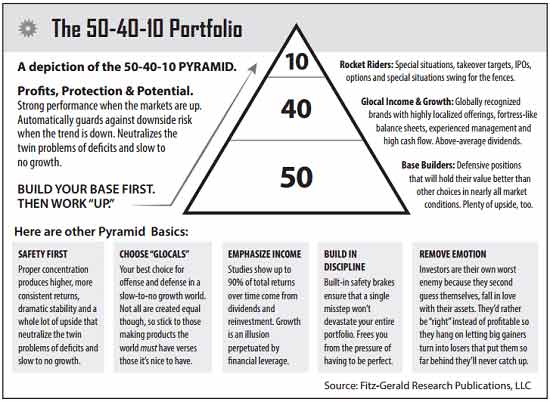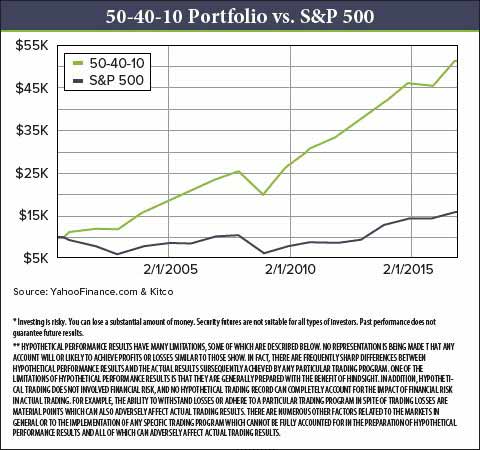Millions rank the Internet right up there with canned beer, sliced bread, and automatic transmissions.
Me?
I think it's the single biggest impediment to profitable investing in the history of mankind.
Never mind all the false news that's making headlines lately - pun absolutely intended - or even the acerbic nature of it. The Internet is simply overwhelming.
There's so much information that many investors are hopelessly confused about what to do next let alone how find profitable investments.
If you're one of 'em, you're not alone. And, you've come to the right place.
What Really Works on Wall Street
If you're of a certain age like I am, chances are you recall futurist Alvin Toffler's groundbreaking 1970 book, "Future Shock," in which he addressed the concept of "information overload" and popularized the notion that huge amounts of information can overwhelm our own limited cognitive processing capacity.
Back then, the average person was subjected to around 500 video, audio, and print ads a day. Now, the figure may top 20,000 exposures a day, which represents a staggering 3,900% increase. It's a sensory assault in the purest sense of the term.
There's simply no way you're going to absorb but a fraction of what you see - and here's the kicker - even if you go looking for it.
That makes investing especially problematic these days.
Contrary to what legions of diligent multitaskers believe, studies show that your brain cannot register really important data when you're hit from all sides by unrelated information - the search you just ran on high dividend producers, a joke from your buddy, the note from your children about an upcoming school play.
One way to deal with this is to limit the use of technology. Experts like London School of Economics Professor Paul Dolan suggest turning off your smart phone a few hours a day. But that doesn't do much for the laptop, your desktop, or the constant "crawlers" you see invading every television screen.
Another is to learn how to "drive" the information superhighway. Companies like Cisco Systems Inc. (Nasdaq: CSCO) and Alphabet Inc. (Nasdaq: GOOG) are trying to teach their employees how to navigate the relentless cycle of information, but have done very little to address the fact that some people measure self-importance by sending out emails you just "have" to answer... off time or not.
Still a third is to have the filtering done for you.
Google, for example, is working ruthlessly to simplify its searches, which is a lesson in irony considering I just got 3.86 million results in .00005 seconds when I googled "information overload." Never mind the privacy invasion that has to happen in order to make this possible.
Not to get too literal here, but there's a reason your smartphone is 18X dirtier than a public toilet seat. We're being hit with so much information today that many people find the only moment they have to themselves is when they're doing their business.
Thing is... not even the smartest filters can help you sort through quadrillions of bytes of data in search of the best investments.
For that, you've got to turn the equation around.
What I mean by that is you have to put a rock-solid investment structure in place first, then go looking for what you want. Doing so will help you automatically find the best companies and invest in them profitably... through thick and thin... and through market conditions that terrify most investors.
Why?
Simply because you will know how each fits with your specific investment goals and objectives before you start looking. Most investors have great intentions and no structure. So they wind up a lot like Christopher Columbus who had no idea where he was going, no idea where he was when he arrived, and no idea where he'd been when he returned.
Wall Street would have you believe that diversification is the answer, meaning that you split your money between a slew of investments on the theory that not everything goes down at once. That's a lot like re-arranging the deck chairs on the Titanic, and about as effective.
Just ask anybody who's watched their 401(k) get turned into a 201(k) twice in the past 17 years - from 2001 to 2002 and again when the Global Financial Crisis hit from September 2008 to March 2009.
The better way is to use something like the 50-40-10 model I advocate in our sister publication, the Money Map Report, which has helped millions of investors who are a part of the Money Map family. Not only does it reduce risk to razor thin levels, but doing so ensures you are using truly non-correlated choices to build wealth and even bigger profits.
It doesn't matter whether you have $500 or $500 million to your name. You can make the 50-40-10 work for your money because it provides the structure you need to navigate today's complicated markets.
Start by grouping your money into three tiers that loosely correspond to the "Food Pyramid" we all grew up with:
The bottom layer - the 50 - is chock-full of stuff your parents told you to eat because it was "good for you" but which probably tasted like wallpaper paste.
The middle layer - the 40 - includes investment choices that are like the food you couldn't get enough of because it tasted great and made you grow.
The third layer - the 10 - is the beer and chips or, as was the case in my house growing up, the ice cream pie. It's the higher risk stuff that can easily pack on a few pounds if you eat too much but which you want because it can take your portfolio to amazingly profitable heights.
Here's what that looks like.

I like the pyramid for a few reasons.
First, it's easy to understand. Our brains like simple shapes as opposed to abstract concepts and that's especially important at a time when we're getting slammed with more data, not less. Plus, it's really easy to show millions of investors how and where to put their money for maximum gains and minimum risk.
Second, the pyramid forces your brain to recognize what needs to happen. Yet another numerical study and reams of paper from New York's Armani Army isn't going to have the same impact. Visually, you understand that the higher you go up the pyramid, the more limited your choices become so there's discipline involved which is great for most investors who lack it. (Try climbing a pyramid some time and you'll see exactly what I mean.)
And, third, organizing your money around a pyramid forces you to "eat" what you need when you need it. That means you'll be able to take advantage of the markets best opportunities without fail when they present themselves and forced to sit on your hands when everybody is scared stiff.
This last point is particularly important because that's where the vast majority of investors doom themselves to terrible returns. They get caught up in their emotions and distracted by the blizzard of data that sets them off on a wild goose chase in the first place. So they start making counter-productive decisions - usually when they can least afford it.
Not surprisingly, this is also when investors who think they're investing find out the hard way that they've been speculating... and poorly at that.
Does it work?
You bet.
I constructed a hypothetical portfolio of just 11 choices and ran it from August 2000 to December 31, 2016, rebalancing it on the first trading day of each year using publicly available data to keep things simple.

I chose those dates very deliberately because a) I hear constantly from investors who are worried the sky is falling, and b) I also hear from those who tell me with a straight face that there's nothing to buy right now and that there hasn't been for years.
During this time we've experienced several wars, recessions, two face-melting market declines, rip-your-face-off rallies, a resurgence of nationalism, and the global equivalent of a political train wreck.
Yet, the 50-40-10 has returned a staggering 412.81% versus a much lower (but still very respectable) 47.46% from the S&P 500 over the same time frame.
No disrespect to people who are worried or those who fear more market madness... what I want you to understand is that history shows beyond a shadow of a doubt that there's a way around almost every obstacle put in your place including the Internet...
...if you have the right structure in place from the get-go.
In closing, I bring this story to your attention because in 14 days, the United States Department of Labor will move forward with a controversial and little-known plan. It'll enable broad and sweeping changes to your retirement - the most dramatic, in fact, since the Retirement Act was written more than 40 years ago, when 401(k)s and IRAs were created.
Washington academics and policy wonks are trying to pass this new change off as "consumer protection," which sounds good on the surface.
But the way I see this playing out just doesn't look good for the average retiree.
Heavy regulation...
Higher costs for brokerage firms...
Increases in the threshold for minimum investible assets...
Restricted availability of certain investments...
A change in fiduciary responsibility...
Low- to middle-income earners getting lost in the fray...
Make no mistake. This regulation was intentionally approved under the radar. You were left out of the decision-making process for a reason.
The good news is that unlike the vast amount of retirees in this country, you now have the 50-40-10 approach in your back pocket. That gives you a tremendous advantage when it comes to capturing the best the markets have to offer while also avoiding periodic corrections and meltdowns that will doom other retirees to an abysmal future.
As great as that is, I still worry that this drastic step by the Federal Government will be a crushing blow to countless American retirees and their families.
So I'm taking action to ensure every one of my readers is prepared.
Tomorrow night, Wednesday, March 29 at 8:00 p.m. Eastern Time, I'm going to host a Retirement Crisis Summit. I'll be on a live call with my publisher, all the way from Tokyo, to share my full findings regarding this impending federal action, and detailed instructions on how to fight back and protect your retirement before the April 10 deadline.
The Retirement Crisis Summit will be free to attend for all members of the Total Wealth Family.
I want every American informed and protected before it's too late.
Click here to sign up.
Best regards for great investing,
Keith
The post How to Profitably Combat Information Overload appeared first on Total Wealth.
About the Author
Keith is a seasoned market analyst and professional trader with more than 37 years of global experience. He is one of very few experts to correctly see both the dot.bomb crisis and the ongoing financial crisis coming ahead of time - and one of even fewer to help millions of investors around the world successfully navigate them both. Forbes hailed him as a "Market Visionary." He is a regular on FOX Business News and Yahoo! Finance, and his observations have been featured in Bloomberg, The Wall Street Journal, WIRED, and MarketWatch. Keith previously led The Money Map Report, Money Map's flagship newsletter, as Chief Investment Strategist, from 20007 to 2020. Keith holds a BS in management and finance from Skidmore College and an MS in international finance (with a focus on Japanese business science) from Chaminade University. He regularly travels the world in search of investment opportunities others don't yet see or understand.



